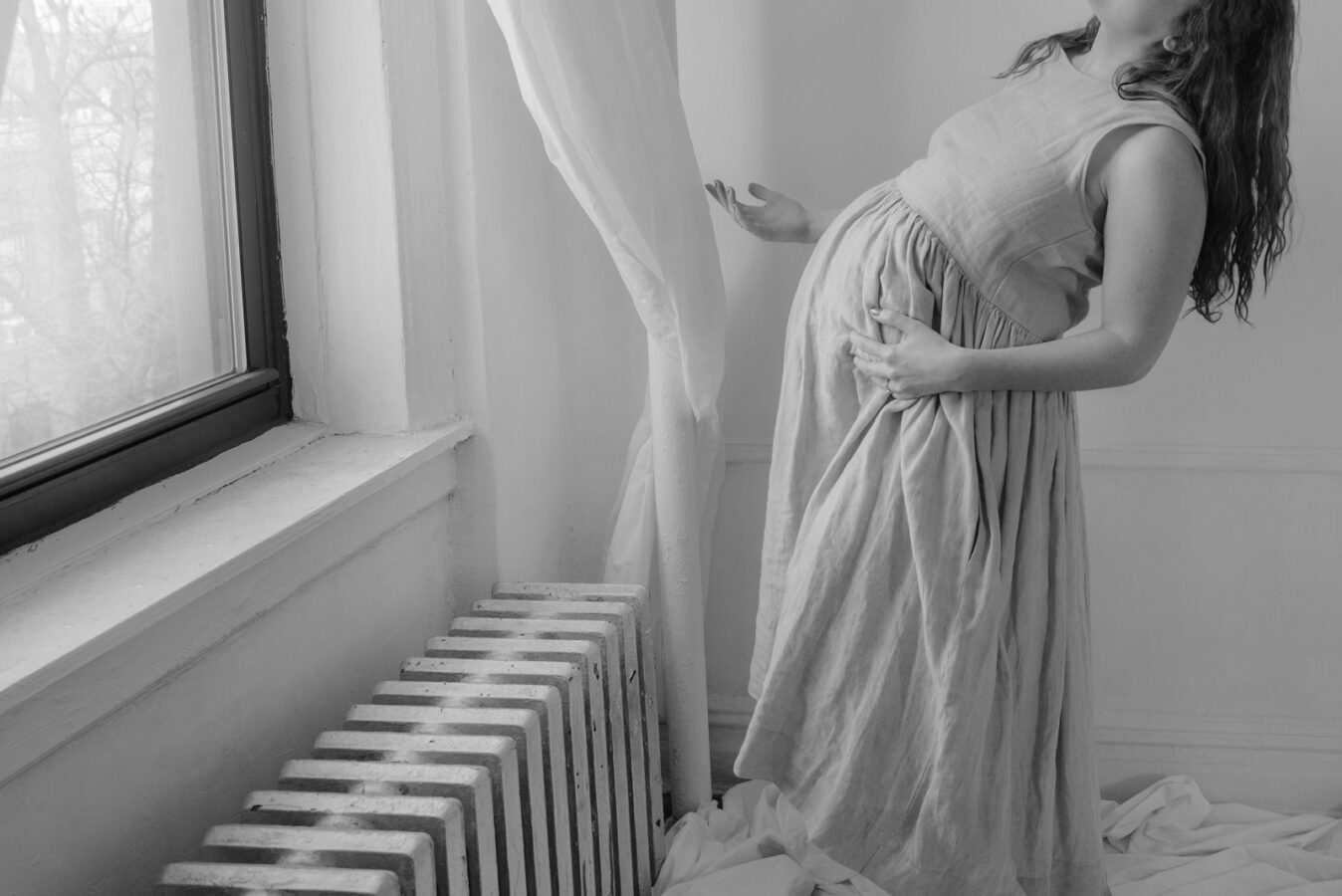Learning to See the Unspoken
Julia Hembree Smith, The Annunciation, 2018, pigment on paper, 11 X 17 in. Courtesy of the artist.
Unhappy that I am, I cannot heave / my heart into my mouth.
So says Cordelia when King Lear demands his daughters make a show of their love for him. All has gone smoothly with the playacting until this moment, when he comes to the child who actually loves him. She says “Nothing.” And Lear, unprepared to acknowledge an inarticulate reality where he commissioned public profession, declares her “a stranger to my heart and me,” and banishes her. Where she leaves, tragedy enters.
Yet it is her mouth, speaking another “nothing” in death, to which Lear calls the audience’s attention at the end of the Folio edition: “Look, her lips— / Look there, look there.” Julia Hembree Smith’s photographs, too, draw the eye to realities which words struggle to hold.
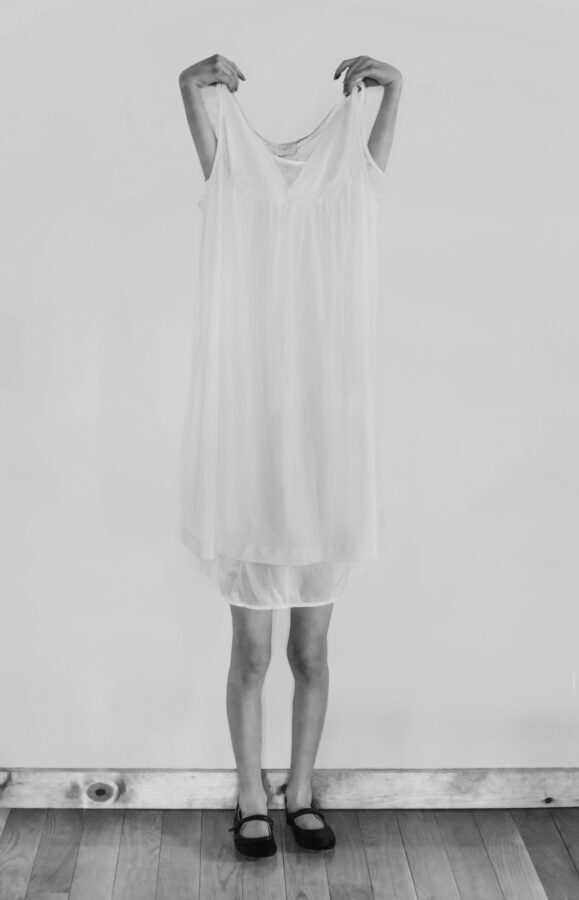
Who among us has not, like Lear, flinched in the face of someone else’s strangerliness: the obvious Other of the lean man who weaves his bicycle down my street, muttering; or the subtler one of a long-loved friend whose mind, after all these years, is still mystery to me, a flame I can see but not grasp. What a thing, to be with you have / no words for it, Mary Szybist writes. What a thing, / to be outcast like that.[1]
Who has not wanted to storm (or worse, erase) that private, foreign place in another, the depth of which may be grief and love and shame, but the face of which is so often frighteningly blank.
Who has not felt this crux also from within? Like Cordelia, we know the impossibility, toward our truest feelings, of speech which does not falsify itself in being said. To utter our quietest griefs, rawest rages, most tiger-tender loves, is often to discover that we’ve said too little—and too much. Yet sometimes it seems a sin (not, perhaps, against any known moral code, but sin against one’s conscience) to say nothing. To not attempt to say something.
Crux, from the Latin, a cross. As in, crux interpretum: a textual passage that evades interpretation.
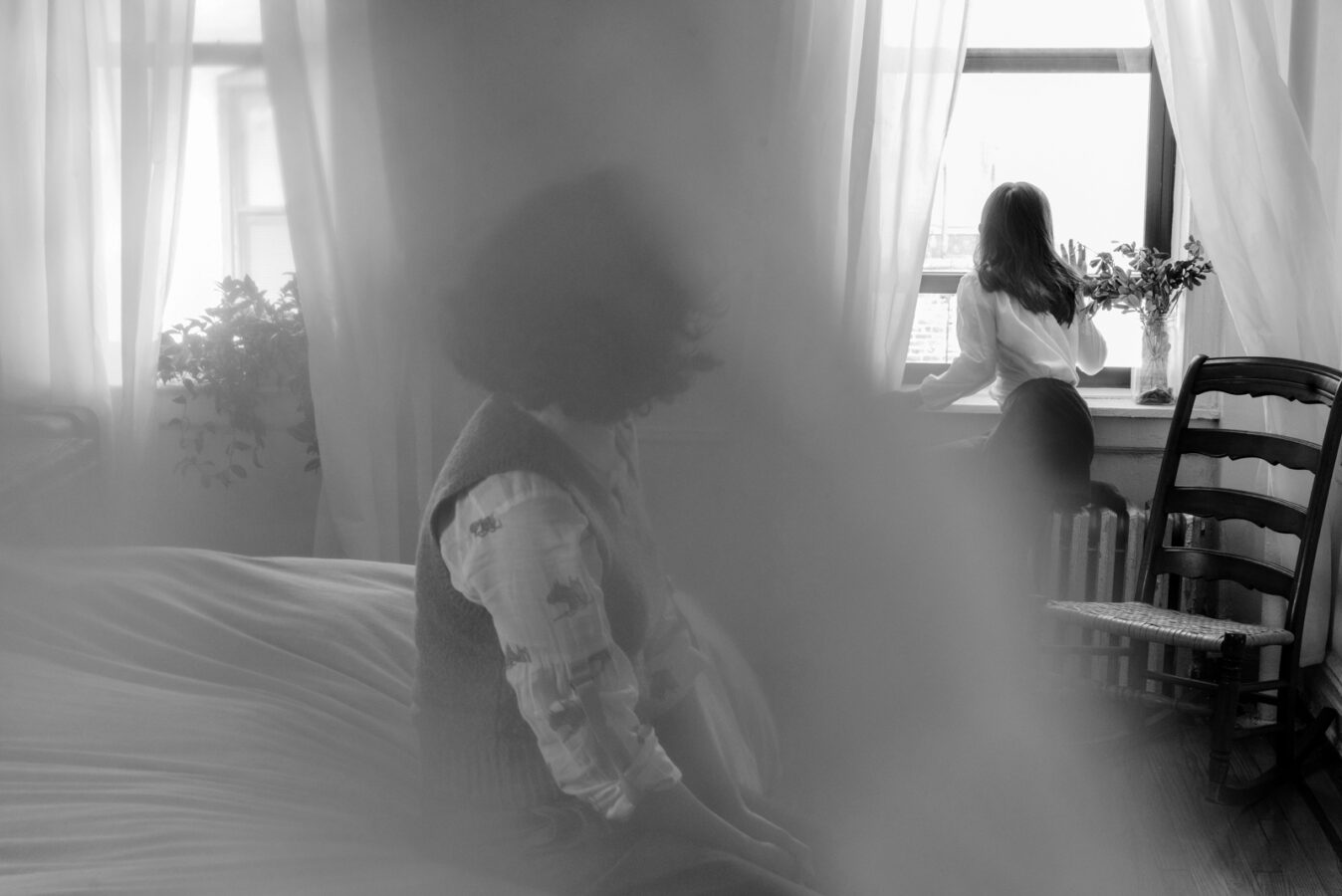
Photography has this advantage over my own medium: it can come to its subjects in silence. Approaching that unspeakable inner world without speaking, it can (sometimes, and with what I take to be great skill and restraint) make its subjects present with pretending to make them known. It can intimately involve us with the strangeness of others—and with our own.
“We say peony,” Jack Gilbert writes, “and make a flower out of that slow writhing.”[2] But photographers can represent without entirely taming.
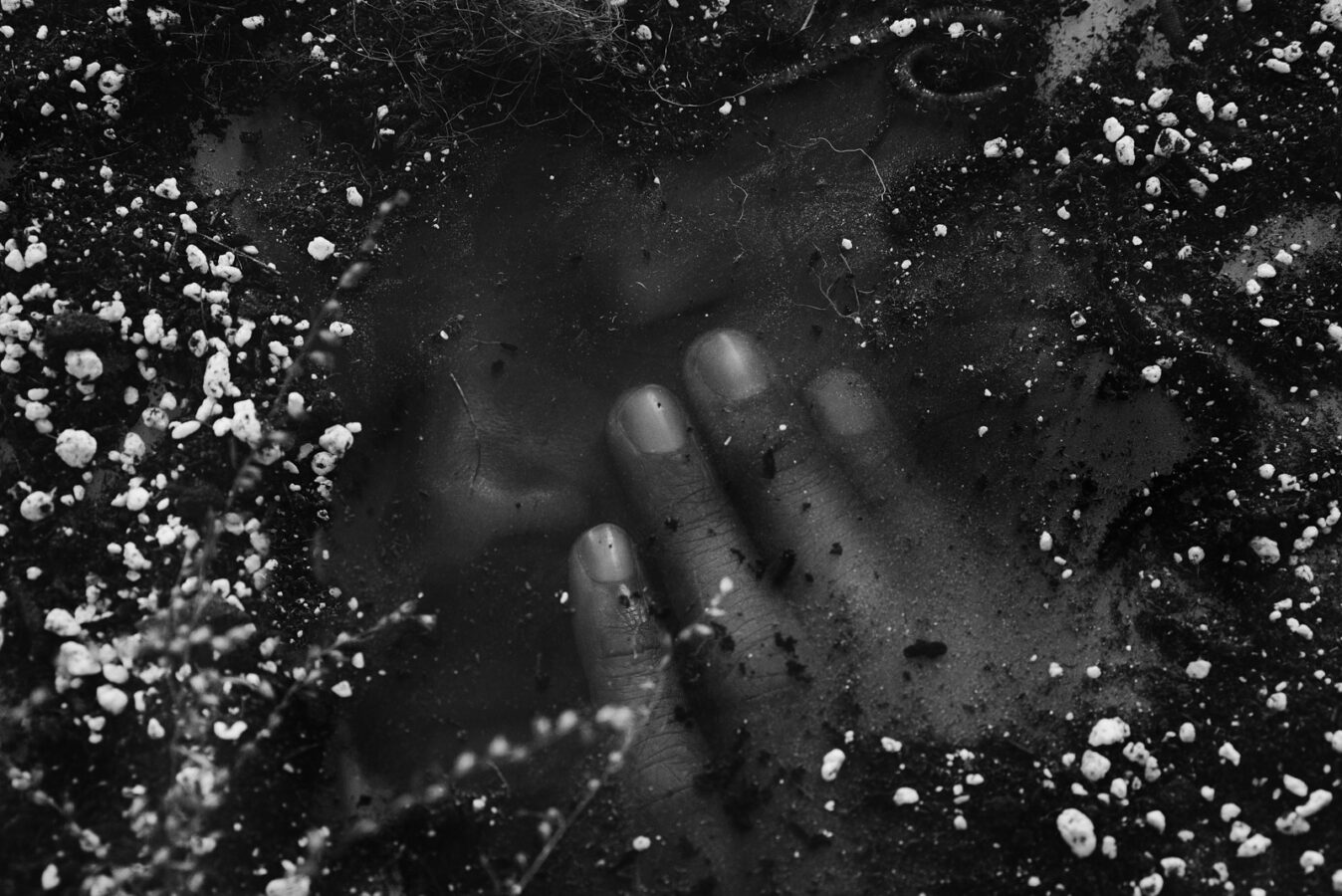
A coil of worm in a cumulous of dirt. A woman wonder-rocked in a room of light. Galaxies of perlite obscuring and revealing nose, lips, eye. The pressed pads of fingertips. Taut tendons on the back of a man’s exposed hand, lifting an armload of trash. Everything is more than itself. Is itself.
Beyond the fundamental, remarkable curiosity of these scenes (how does this face appear as if from underground? why? and why all the garbage bags? what grit or slick coat this worm’s sides? who will she be, the scrawny girl with her scrawny knees?), what involves me most with Smith’s images is the subjects’ gaze. See how often the gaze is away from us, or hidden from us. Veiled, obscured, layered, redirected. It is framed out. Otherwise occupied. And I am pulled in after it, struck with a sense that the gaze is not being withheld from me so much as permitted to be its own.
This is precisely what Lear would not bear. The illusion of comprehension and unhindered intimacy between persons breaks down, making the viewer aware of her own inner seclusions and unspoken truths. “If thou wilt weep my fortunes, take my eyes,” Lear deflects his blind friend, Gloucester. Don’t show me myself. As Stanley Cavell points out in his essay on Lear, sight is intimately bound to being seen.[3]
Somehow we as viewers are placed on a level playing field with the subjects. There is a silence I don’t understand, don’t know how to speak, on both sides of this lens, and the one reveals the other.
Smith’s compositions emphasize this: a blown curtain, soiled glass, a yard of linen—her layering renders the line of sight itself visible, along with its limitations. We have a vantage point, have eyes, which possess certain powers and particular inabilities. Ours is not omniscient scope but human sight, situated across barriers, within shared embodiment. Each visual “obstruction” blurs outlines yet adds clarity of meaning. The glass and earth so obviously make the “Worm” series, but so does the subtle line of bushes in the foreground of “Green Grass, Tall Fences,” and the curtain shrouding our view of the mother in “Her World.”
Note that to see oneself seeing is to become—ever so slightly—a different self.
When Smith discloses the undisclosed interior for what it is, the effect is not of estrangement but of gravely tender intimacy. To leave space for one another to be unknown may in fact close the distance between souls as nearly as we can.
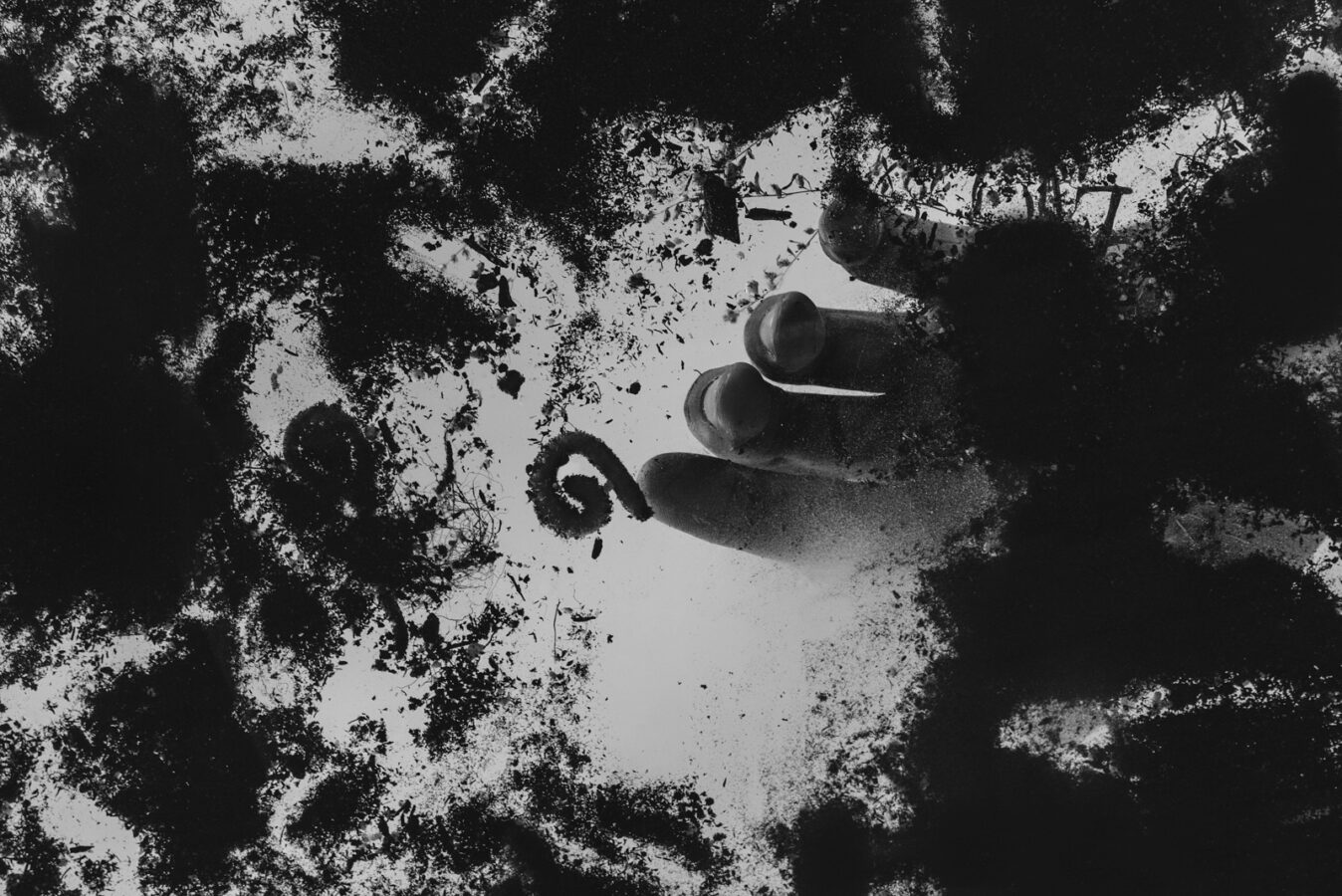
Obviously there is much more happening in these photographs than portraiture (and the artist’s homages to Andrew Wyeth, Jeff Wall, and Gregory Crewdson stress this deeper purpose), yet I think this is partly because Smith starts from a point which is never less than portraiture. “What are you doing here lying in wait for happiness,” Yehuda Amichai writes, “With your lovely face a tourist advertisement from God / And your soul rent and torn like mine?”[4] To recognize the holy, particular life of another person is to feel one’s own heart turn in the chest, loosened from sleep like an iris untwisting its silken, purple Yes.
Is this portraiture? iconography? symbolism? To see that we are all so much more than we can see, tangled in long lines of growth and disintegration which run out in every direction from the photographed, beholding moment, terrifyingly headlong and hopeful and unknown, involved one with another like the intertwined roots of trees. Perhaps there’s a kind of seeing where these distinctions blur and overlap, where the truest symbolic vision is the most deeply personal, where the most honest portrait is iconographic.
Gerard Manley Hopkins writes of the life “deep down things,”[5] and if it is a life which resists and embarrasses language, yet its deep does call to deep.
Or perhaps we, like Lear, are the ones who resist what cannot be contained in a word. It takes spacious seeing and speaking to leave a chink where the shock of soul may flash upon us; the jagged edge of one deep-down life meets the shard of another, and sparks erupt in all their heat and danger. For who knows what such visions will make of us, our rough-hewn selves ground against the untold consequences of love amid limitation. Spencer Reece, another poet priest, writes: We were bound, bound by a vow, a vow of attention / (there are many causes for attention, among them redemption).[6]
Every now and again, we have the chance to apprentice our eyes to someone else’s sight. Here in Smith’s work we have a school of seeing, we have attention honed till its edge sings as it spins on the whet.

[1] Szybist, Mary. “Long after the Desert and the Donkey.” Incarnadine. Graywolf Press, 2013, pp. 20-21.
[2] Gilbert, Jack. “They Call It Attempted Suicide.” Collected Poems. Knopf, 2012, p. 79.
[3] Cavell, Stanley. “The Avoidance of Love.” Disowning Knowledge. Cambridge UP, 2003, pp.39-123.
[4] Amichai, Yehuda. “Lying in Wait for Happiness.” The Poetry of Yehuda Amichai, edited by Robert Alter, FSG, 2015, p. 275.
[5] Hopkins, Gerard Manley. “God’s Grandeur.” Gerard Manley Hopkins: Poems and Prose. Penguin, 1985, p.27.
[6] Reece, Spencer. “The Road to Emmaus.” The Road to Emmaus. FSG, 2014, p.65.
